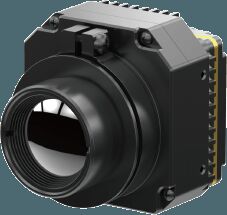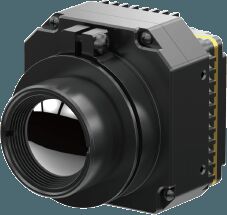-
Thermal Camera Core
-
Thermal Security Camera
-
Drone Thermal Camera
-
Plug-in Thermal Camera
-
Cooled Infrared Detectors
-
Cooled Camera Modules
-
Optical Gas Imaging
-
Infrared Thermal Camera Module
-
High Resolution Thermal Camera Module
-
Thermal Camera For Fever Detection
-
Vehicle Mounted Thermal Camera
-
Integrated Dewar Cooler Assembly
-
Uncooled Infrared Detectors
Uncooled Thermal Surveillance LWIR Camera Module 640x512 8~14μm LW

Contact me for free samples and coupons.
Whatsapp:0086 18588475571
Wechat: 0086 18588475571
Skype: sales10@aixton.com
If you have any concern, we provide 24-hour online help.
x| Resolution | 640x512 / 17μm | NETD | <30mK |
|---|---|---|---|
| Camera Lens | Multiple Available | Frame Rate | 9Hz/25Hz/30Hz/50Hz/60Hz |
| Start-up Time | <10s | Spectral Range | 8~14μm LW |
| Highlight | LWIR Thermal Surveillance Camera,Surveillance LWIR Camera Module,Uncooled LWIR Camera Module 640x512 |
||
PLUG617 LWIR 640x512 / 17μm Uncooled Thermal Camera Module for Security and Monitoring
PLUG617 LWIR infrared module is one of the PLUG series that are developed by SensorMicro. The PLUG617 uncooled infrared camera core with a resolution of 640x512 and a pixel size of 17um is an ideal solution for security monitoring applications. This type of camera core offers high-quality thermal imaging capabilities, even in complete darkness or adverse weather conditions.
One of the key advantages of uncooled infrared camera cores is that they do not require a cryogenic cooler, which greatly simplifies the design and reduces the cost of the camera system. This makes uncooled infrared cameras ideal for a wide range of security monitoring applications, including surveillance, perimeter protection, and intrusion detection.
The high-resolution 640x512 sensor and small pixel size of 17um provide exceptional image clarity and detail, allowing even small temperature differences to be detected in the thermal image. This level of detail is essential for security monitoring applications, as it can help identify potential threats or anomalous behavior that might otherwise go undetected.
- NETD<30mk, High Sensitivity
- Stable Performance
- Easy Integration & Plug-in
- Clear Image Quality & Details
- Strong Environmental Adaptability
| Model | PLUG617 |
| IR Detector Performance | |
| Resolution | 640x512 |
| Pixel Pitch | 17μm |
| Spectral Range | 8~14μm |
| NETD | <30mk |
| Image Processing | |
| Frame Rate | 9Hz/25Hz/30Hz/50Hz/60Hz |
| Start-up Time | <10s |
| Analog Video | PAL/NTSC |
| Digital Video | RAW/YUV/BT656/LVDS |
| Extension Component | USB/Camerlink |
| Dimming Mode | Linear/Histogram/Mixed |
| Digital Zoom | 1~8X Continual Zoom, Step Size 1/8 |
| Image Display | Black Hot/White Hot/Pseudo Color |
| Image Direction | Horizontally/Vertically/Diagonally Flip |
| Image Algorithm | NUC/AGC/IDE |
| Electrical Specification | |
| Standard External Interface | 50pin_HRS Interface |
| Communication Mode | RS232-TTL, 115200bps |
| Supply Voltage | 4~6V |
| Typical Power Consumption | <1.2W |
| Physical Characteristics | |
| Dimension (mm) | 44.5x44.5x36.6 |
| Weight | <90g |
| Environmental Adaptation | |
| Operation Temperature | -40°C ~ +70°C |
| Storage Temperature | -45°C ~ +85°C |
| Humidity | 5%~95%, Non-condensing |
| Vibration | Random Vibration 5.35grms, 3 Axis |
| Shock | Half-sine Wave, 40g/11ms, 3 Axis 6 Direction |
| Optics | |
| Optional Lens | Fixed Focus Athermal: 7.5mm/13mm/19mm/25mm/35mm/50mm/60mm/100mm Motorized Lens: 75mm/100mm/150mm Continuous Optical Zoom: 30-150mm |
The PLUG617 thermal camera module can be integrated into security cameras with temperature monitoring from short distance to ultra distance, such as PTZ Camera, Box Camera, Speed Dome Camera.
![]()
Customized Service
Product Customization: Adjust configurations and adapt algorithms to meet industry-specific requirements
On-Site Technical Support & Training: Provide core customers with hands-on system setup and operational training
Joint Innovation for New Products & Markets: Collaborate with customers to co-develop innovative infrared application solutions
1.How does an infrared detector work?
Infrared detectors work by sensing electromagnetic radiation in the infrared range. The exact mechanism of detection varies depending on the type of infrared detector.
Thermal detectors work by measuring the temperature change caused by absorbing the infrared radiation. For example, microbolometers consist of a matrix of tiny resistive elements that are sensitive to heat. When infrared radiation is absorbed by the detector, it causes the temperature of the resistive element to increase, resulting in a change in electrical resistance that can be detected and converted into an image.
Photon detectors, on the other hand, work by converting photons from the infrared radiation into electrical signals. Two common types of photon detectors are photovoltaic detectors and photoconductors. Photovoltaic detectors generate a voltage when infrared photons are absorbed, while photoconductors increase their conductivity when photons are absorbed.
Infrared detectors can also utilize other detection mechanisms, such as pyroelectricity, where changes in temperature induce a charge in a material, or thermoelectric effects, where a temperature difference between two materials generates a voltage.
The output signal from the infrared detector can be processed and displayed as an image, which can be used for a variety of purposes, such as thermal imaging in medical or industrial applications, remote sensing of the environment, and thermal scanning in security systems.




